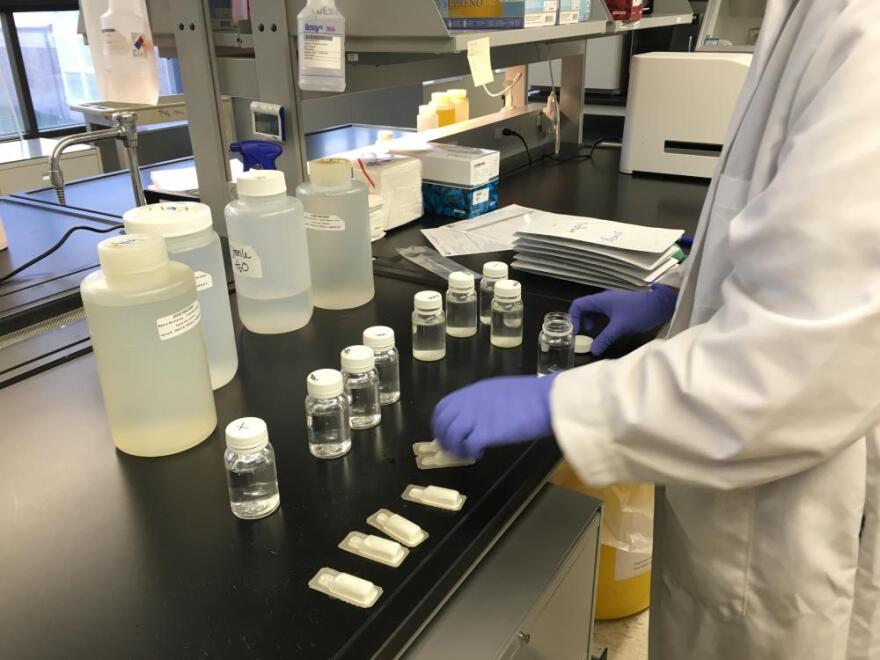By Elizabeth Miller
According to the EPA, 184 communities in the Great Lakes Basin have outdated sewer systems that can carry harmful bacteria into waterways. Solutions to the problem are part of what’s called a “green” versus “gray” infrastructure debate.
Villa Angela-Euclid Beach on Cleveland’s east side is consistently ranked not only Cleveland’s dirtiest beach in terms of water quality, but one of the worst in the country. The Northeast Ohio Regional Sewer District takes water samples at the beach every day during the summer. So far, it's been closed for 44 days.
NEORSD’s Brianna Boggan walks into the water with overalls and wader boots to take the day’s sample.
“I’m using our Hanna meter to grab our parameters. We take temperature, we take conductivity, and we take the ph of the water,” described Bogan.
The sample makes its way to the lab, where it’s tested for bacteria like e-coli. The test takes a full 24 hours, but scientists use predictive modeling to make a same-day announcement of “good” or “poor” water quality. NEORSD uses E. coli as an indicator organism because its presence shows fecal contamination.
U. S. Forest Service scientist Michelle Kondo explains how a “poor” water rating can stem from outdated combined sanitary and storm sewer systems subject to overflow. “When it rains really hard, -the untreated water flows directly into surface waters, like Lake Erie,” said Kondo. “These overflows happen an average of up to 82 times per year at some outfalls in Cleveland, for example.”
Kondo studies the impact of Green Stormwater Infrastructure, or GSI. It uses vegetation and greenery including patches of trees and shrubs to slow water’s journey to combined sewers. Ohio Division of Forestry’s Alan Siewert says trees act like giant umbrellas to help prevent surges of water that cause overflows.
“The first 15% of the rain falling never makes it to the ground,” said Elving. “It’s captured on the leaf surface, on the bark and eventually evaporates.”
Scientists like Kondo say “green” infrastructure can serve as a substitute or complement what’s called “gray” concrete infrastructure, which involves building and updating storm water systems. Her research aims to evaluate green projects in cities like Philadelphia.
“Many cities really like the green approach because it comes with environmental, social, economic, and public health benefits,” said Kondo.
Cleveland hopes to capitalize on such benefits as part of the Northeast Ohio Regional Sewer District’s Project “Clean Lake.” The $3 billion program includes “green” projects like rain gardens in Slavic Village and basins to hold excess storm water in the Kinsman neighborhood.
18 miles west along the shores of Lake Erie, the city of Avon Lake endorses a more “gray” approach. It includes a mandate that owners of homes with outdated systems separate their sewers by 2018. Todd Danielson is with the Avon Lake water department.
“Avon Lake is a tree city – we love trees,” said Danielson. “But just does not stop enough of the water from getting into the sewers. For us, the biggest issue really is the water coming from private property.”
Danielson says currently, “green” solutions are easier to implement in bigger cites.
“If we can find ways to use it, I would wholeheartedly support it,” said Danielson.
“We are also in the early phases of learning not just how to implement GSI, but how to manage and maintain the green infrastructure.”
While Forest Service studies by researchers like Michelle Kondo continue to show public health benefits of “going green” in cities like Philadelphia, Kondo admits it remains a balancing act. “Even cities that are known for taking this bold, green approach also have gray improvements going on,” said Kondo.
Kondo notes Seattle, New York City, and Minneapolis as other cities embracing the “green”.
Meanwhile, for those who want to enjoy a nice afternoon in Lake Erie, high bacteria counts remain a conundrum to be solved, according to forester Alan Siewert.
“It used to be when we wanted to go the beach, we worried if it was warm enough and should we pack sunscreen,” said Siewert.
“Now our first concern is, ‘what’s the bacteria level?’”
This month, the U-S EPA announced 2 million dollars to fund green infrastructure projects to reduce storm water runoff in 13 cities, including 5 in northeast Ohio.
Check out Ohio beach advisories at the Ohio Department of Health's BeachGuard site.
Video transcript:
LANNAN: This is a regent – a polar regent that tests specifically for E. coli. It's an enzyme substrate reagent. So when the E. coli consumes or digests the reagent, the metabolite it gives off will fluoresce if it’s the specific E. coli that consumes the reagent.
It also has enzymes in it that prevent other bacteria from growing. So when the E. coli consumes the reagent, it will give off a metabolite that fluoresces under UV light. Then we use the fluorescents from the wells of the trays to calculate how many E. coli is in that specific sample.



